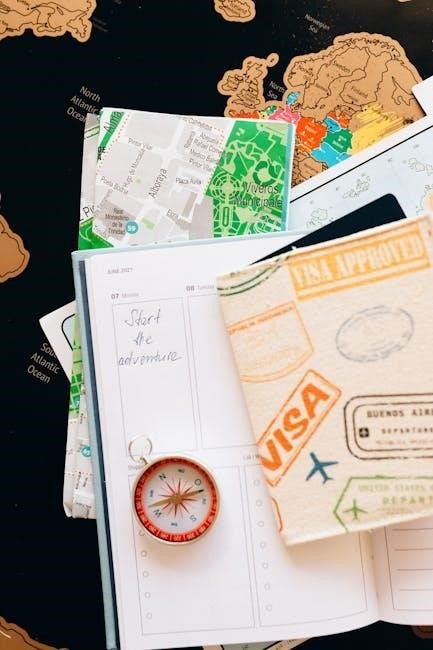Choosing the right planner size is essential for productivity and organization. Sizes range from large A4 to compact Pocket, each serving different purposes. This guide helps you find the perfect fit for your lifestyle and planning needs, ensuring efficiency and convenience in task management.

Common Planner Sizes
Planners come in various sizes, including A4, Letter, A5, B5, Personal, Pocket, A6, and Half-Letter. Each size caters to different needs, from portability to ample space for detailed planning, ensuring there’s a fit for everyone’s lifestyle.
A4 Size
The A4 size is one of the most widely used planner formats, measuring 8.27 by 11.7 inches (210mm x 297mm). Popular outside the US, it offers ample space for detailed planning, notes, and calendar layouts. Its large surface area makes it ideal for those who prefer a spacious design. A4 planners are often used in professional settings due to their versatility and compatibility with standard office printers. They are slightly larger than US Letter size but share similar proportions. This size is perfect for individuals who need room for elaborate spreads or artistic layouts. However, its bulkiness may not suit those prioritizing portability. A4 planners are commonly paired with robust binding systems, ensuring durability. For users who value space and functionality, the A4 size remains a top choice for organizing tasks and projects efficiently.
Letter Size
Letter size, measuring 8.5 by 11 inches (216mm x 279mm), is a popular choice in the US and other regions. It provides a generous workspace, making it ideal for detailed planning and note-taking. While similar to A4, it is slightly wider and longer, offering a unique layout experience. Letter size planners are often preferred for their balance between portability and usability. They fit easily into standard bags and briefcases, making them suitable for daily use. This size is versatile, accommodating various planning styles, from minimalist layouts to elaborate designs. Letter size planners are widely available and compatible with most printing systems, making them a practical option for both personal and professional use. Their slightly larger dimensions compared to A4 allow for more creative freedom, ensuring that users can organize their tasks and ideas effectively without compromising on space.
A5 Size
A5 size planners, measuring 5.83 by 8.27 inches (148mm x 210mm), are a popular choice worldwide, especially in Europe and Australia. This size is compact yet spacious enough for daily planning, making it ideal for those who prefer a balance between portability and usability. A5 planners are easy to carry in bags or purses, ensuring they are always accessible. Their moderate size allows for detailed note-taking without feeling cramped, making them suitable for both personal and professional use. Many users appreciate the versatility of A5 planners, as they can accommodate a variety of layouts, from minimalist designs to more elaborate spreads. Additionally, A5 is a standard size for printing and binding, making it widely available in stores and online. Its popularity ensures a broad range of styles and designs, catering to diverse preferences and planning needs.

B5 Size
B5 size planners, measuring 6.93 by 9.85 inches (176mm x 250mm), are widely used for their balance of space and portability. This size is ideal for individuals who prefer a larger writing area without the bulk of A4 planners. B5 planners are particularly popular in Japan and among enthusiasts who value detailed planning. The extra space allows for elaborate spreads, making it suitable for artistic or highly organized layouts. Despite its larger dimensions compared to A5, B5 planners are still compact enough to fit into medium-sized bags, offering practicality for daily use. They are also versatile, accommodating a variety of binding styles and designs. B5 planners are a favorite among stationery lovers who appreciate the size for both functionality and aesthetics, making them a great choice for those seeking a midpoint between A5 and A4 sizes.
Personal Size
Personal Size planners are a popular choice for those seeking a balance between portability and ample writing space. Typically measuring 3.75 by 7 inches, this size is slightly larger than Pocket Size but smaller than A5, making it ideal for everyday use. The compact dimensions allow it to fit easily into most bags and purses, while still providing enough room for detailed planning. Personal Size planners are often preferred by individuals who value organization without the bulk of larger sizes. They are commonly used for daily or weekly spreads, to-do lists, and goal setting. Many users appreciate the variety of layouts available for this size, from minimalist designs to elaborate artistic spreads. Its versatility and practicality make the Personal Size a favorite among both professionals and students who need a reliable planner that fits into their active lifestyles.
Pocket Size
Pocket Size planners are the smallest and most portable option, measuring approximately 3.5 by 5.5 inches; This compact size is ideal for individuals who prioritize convenience and ease of carrying. Designed to fit into small bags, pockets, or purses, Pocket Size planners are perfect for on-the-go use. They are great for jotting down quick notes, reminders, or maintaining a minimalistic daily schedule. Despite their small dimensions, Pocket Size planners often feature clever layouts that maximize space, making them functional for simple planning needs. This size is particularly popular among students, professionals with busy lifestyles, and those who prefer a no-frills approach to organization. The portability of Pocket Size planners ensures they are always accessible, making them a practical choice for anyone seeking a lightweight and easy-to-handle planning tool. Their compact nature encourages focused and prioritized planning, appealing to users who value simplicity and efficiency.
A6 Size
A6 Size planners measure approximately 4.1 by 5.8 inches, making them a popular choice for those who prefer a compact yet functional planning tool. This size is widely used internationally and is known for its portability, fitting easily into small bags, pockets, or even wallets. A6 planners are ideal for daily use, offering enough space for essential tasks, appointments, and notes without being overly bulky. They often feature layouts designed for simplicity, such as daily or weekly spreads, to-do lists, and small sections for jotting down ideas. The A6 size is particularly favored by students, professionals, and minimalists who value a balance between usability and portability. Its compact dimensions make it easy to carry, while its practical design ensures it remains a versatile option for various planning needs. A6 planners are also a great choice for those who prefer a smaller, more discreet tool for organizing their time. Their size and functionality make them a timeless favorite in the world of planners.

Half-Letter Size
The Half-Letter Size planner measures 5.5 by 8.5 inches, making it a popular option for those who need a medium-sized planning tool. This size is ideal for individuals who prefer more space than smaller planners like A6 or Personal Size but still want something manageable. Half-Letter planners are widely used for daily or weekly spreads, offering ample room for detailed notes, task lists, and creative layouts. They are often favored by professionals, students, and bullet journalists who appreciate the balance between portability and usability. The size is also perfect for adding inserts, stickers, or colorful decorations, making it a versatile choice for customization. Half-Letter planners are commonly paired with 3-ring binders or disc-bound systems, allowing users to easily add or remove pages. Their size and functionality make them a great middle ground between larger and smaller planners, catering to a variety of planning styles and preferences.

How to Choose the Right Planner Size
Selecting the ideal planner size involves considering your lifestyle, available space, and planning style. Assess how portable it needs to be, the amount of writing space required, and personal comfort. Choose a size that balances practicality, functionality, and aesthetics to suit your daily needs effectively.
Considering Lifestyle Needs
Your lifestyle plays a crucial role in determining the ideal planner size. Busy professionals may prefer compact sizes like Personal or Pocket for easy portability, while students might opt for A5 or Letter sizes to accommodate notes and schedules. Stay-at-home parents may benefit from larger sizes like A4 for managing family calendars and tasks. If you’re frequently on-the-go, a smaller planner like A6 or Half-Letter might be more practical. Consider how much writing space you need: detailed planners may require larger pages, while minimalists can thrive with smaller layouts. Think about your daily activities and how much time you spend planning. A planner that fits seamlessly into your routine will be more likely to enhance productivity and satisfaction. Assessing your lifestyle helps narrow down the options, ensuring your planner becomes a trusted daily companion rather than a bulky afterthought.
Assessing Bag Space
When selecting a planner size, consider the space available in your bag or purse. If you carry a large tote or backpack, an A4 or Letter-sized planner may fit perfectly. However, if you prefer smaller bags, such as a crossbody or clutch, opt for compact sizes like Personal, Pocket, or A6. Measure your bag’s interior to ensure your planner fits comfortably without bulging or getting damaged. A planner that’s too large for your bag may be left behind, rendering it ineffective. Conversely, a planner that’s too small might be easily misplaced. Strike a balance by choosing a size that complements your bag’s dimensions. For example, a B5 or Half-Letter planner is ideal for medium-sized bags, while A5 works well for most everyday purses. Assessing your bag space ensures your planner remains a practical and portable tool, always within reach when you need it.
Matching Planning Style
Your planning style plays a significant role in determining the ideal planner size. If you prefer a minimalist approach with simple layouts, smaller sizes like Personal, Pocket, or A6 are ideal. These sizes allow for clean, uncluttered spreads without overwhelming space. On the other hand, if you enjoy detailed planning with intricate designs, larger sizes like A4 or Letter provide ample room for creativity. For those who balance simplicity with functionality, A5 or B5 planners offer a versatile canvas for daily or weekly layouts. Additionally, consider whether you prefer vertical or horizontal layouts, as some sizes accommodate these formats better than others. Matching your planner size to your planning style ensures a seamless and enjoyable experience, helping you stay organized and motivated. By aligning your tools with your preferences, you create a system that works intuitively for you, making planning a habit rather than a chore.
Planner Printing and Binding Guide
Choose high-quality paper for durability and smooth writing. Opt for spiral or perfect binding for flexibility. Consider laminated covers for protection. Test prints ensure layouts fit your chosen size. Printing in bulk saves time and resources.

Downloading Test Prints
Downloading test prints is a crucial step in ensuring your planner layout fits perfectly. Start by sourcing templates from trusted platforms like Etsy or free resources online. Print samples on standard paper to check alignment and formatting. Adjust margins and scaling as needed to avoid cutoff text. Use this opportunity to verify dates, layouts, and design elements. Test prints reveal potential issues before final printing, saving time and materials. Always preview PDFs at 100% scale to gauge real size. Consider printing on scrap paper to minimize waste. This step ensures your planner is functional and visually appealing. Regularly update templates to maintain accuracy. Testing different orientations (portrait vs. landscape) helps determine the best fit. Avoid common mistakes like incorrect page sizes or mismatched bindings. By refining your prints, you achieve a polished, professional result tailored to your needs.

Understanding Hole Punching
Hole punching is essential for creating functional and organized planners. It allows pages to be securely stored in binders or rings, ensuring easy access and customization. There are various tools available, including single-hole, double-hole, and adjustable punches, which cater to different planner sizes and binding systems. Standard ring sizes, such as 6mm, 8mm, and 1 inch, require precise hole spacing to fit properly. Before punching, measure the distance between holes to align them correctly. Using a guide or ruler ensures consistency and prevents misaligned holes. Test punches on scrap paper to avoid errors. For accuracy, punch one hole at a time and maintain a firm grip on the tool. Regularly clean and oil your punch to keep it functioning smoothly. Proper hole punching prevents pages from tearing and ensures they lie flat, enhancing the planner’s usability and durability. This step is crucial for maintaining a polished and professional appearance in your planner setup.

Planner Size Comparisons
Planner size comparisons help users identify the best fit for their needs. Common comparisons include A4 vs Letter, A5 vs B5, and Personal vs Pocket sizes, highlighting differences in portability, usability, and functionality.
A4 vs Letter Size
The A4 and Letter sizes are two of the most widely used planner formats, but they differ slightly in dimensions. A4 measures 210mm x 297mm, while Letter size is 216mm x 279mm. Both are suitable for detailed planning, but A4 is slightly taller and narrower, whereas Letter is shorter and wider. A4 is commonly used in Europe and Asia, while Letter size is standard in North America. When choosing between them, consider availability and compatibility with printing standards in your region. A4 offers more vertical space, which may appeal to those who prefer writing or drawing, while Letter size is more compact and portable. Binding and hole punching options also vary slightly between the two sizes. Ultimately, the choice depends on personal preference, lifestyle, and the tools you plan to use with your planner.

Popular Planner Brands and Their Sizes
Several well-known planner brands offer a variety of sizes to cater to different preferences and needs; Erin Condren, for instance, provides planners in sizes like A5, Personal, and even larger options for detailed planning. Happy Planner offers sizes ranging from B6 to A5, as well as smaller “Mini” versions for on-the-go use. Passion Planner is widely recognized for its A5 and compact options, which are ideal for both professionals and students. Filofax and Traveler’s Notebook also cater to diverse audiences, with sizes like A5, Personal, and smaller A6 options. Leuchtturm1917, known for its high-quality notebooks, offers planners in A5 and Pocket sizes. These brands often design their planners with specific user lifestyles in mind, ensuring there’s a size to suit every preference, whether for portability, ample writing space, or a balance between the two.

Planner Trends and Future Directions
Planner trends are evolving to meet the changing needs of users, with a growing emphasis on sustainability, customization, and digital integration. Many brands are now offering eco-friendly options, such as recycled paper and biodegradable covers, appealing to environmentally conscious consumers. Personalization is also on the rise, with users seeking planners that align with their unique lifestyles, whether through interchangeable covers or modular layouts. Additionally, the integration of digital tools, such as QR codes linking to downloadable templates or companion apps, is becoming more common.
Looking ahead, the future of planners may see even more innovative designs, such as smart planners with embedded technology or augmented reality features. There is also a potential shift toward niche-specific planners, catering to professionals, students, or individuals with specific hobbies. As preferences continue to diversify, the planner industry is likely to expand its offerings, blending tradition with modern innovation to remain relevant in a fast-paced world.
